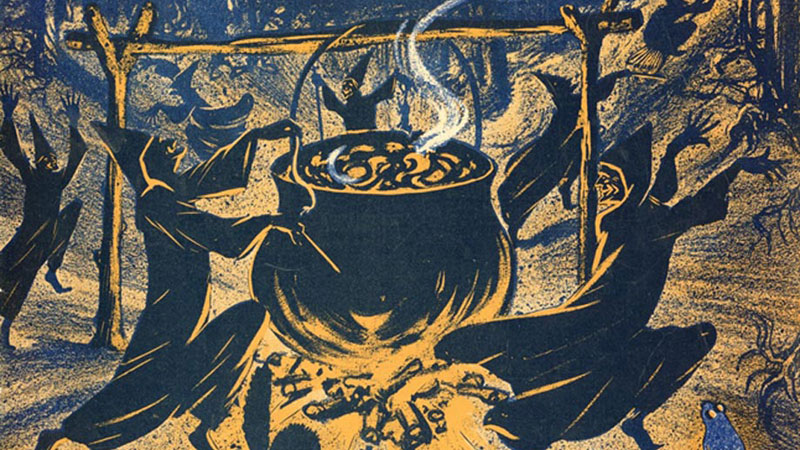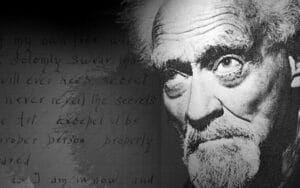Guest writer NIXIE VALE takes a look at the history of witchcraft through the ages…

I was reading an article a little while ago about the Salem Witch trials, and it got me thinking about the history behind the Witch trials, what set off the witch craze that spread through Europe and eventually made it over to America. When the witch craze was at its height in Europe, America was a mere glint on the societal horizon. Medieval Europe was a vastly different place from what we know today, the elite few ruled the many and the Pope ruled the few. It was a time when if you were even slightly different, or you didn’t think they same way you were ostracized, and even accused of all kinds of things, one of the ‘favourites’ was accusing someone who was different, infirm, elderly etc… of Witchcraft.
In Medieval Europe witchcraft was perceived to facilitate the summoning of demons, the devil and other evil spirits, and back then the church had the power to punish anyone who was accused of witchcraft and sorcery. The priests had the power to exorcise anyone they believed to be possessed by evil spirits. This was a time when people believed in witchcraft, and that it was to blame for all the ill fortune and bad luck that befell people. If the crops failed, if a child dies prematurely, or if livestock died witchcraft was blamed, and the fear of witches led to a witch-craze that spread through all walks of life.
The Hammer of Witches
In The Da Vinci Code, Leigh Tebing calls it “the most blood soaked book in history”. The Hammer of Witches, or the Witch Hunter’s Bible are other names for a book called the Malleus Maleficarum, and it was a book that has influenced the people writing laws throughout history, changing the world people knew. The Malleus Maleficarum was written and published in 1486. Heinrich Kramer was given a Papal Bull called “Summis desiderantes affectibus” [Desiring with Supreme Ardor] from Pope Innocent VIII in 1484, which allowed him to write this document. The belief in witchcraft itself goes back as far back as the Old Testament, and is mentioned in both Deuteronomy and in Exodus.
- Deuteronomy 18:11-12: “Let there not be found among you anyone who immolates his son or daughter in the fire, nor a fortune-teller, soothsayer, charmer, diviner, or caster of spells, nor one who consults ghosts and spirits or seeks oracles from the dead.”
- Exodus 22:18: “You shall not permit a sorceress to live”
Kramer took this Papal Bull as permission to write a book about the hunting of witches and how to identify them out of those accused. This Papal Bull brought about 400 years worth of witch-hunts, witch trials and hysteria, however, the Pope soon changed his mind and withdrew the support of the church.
About the Book, Malleus Maleficarum
The Malleus Maleficarum was a root cause of all the torture and executions relating to witches, and the quotes above led so many to fear and hate witches in the medieval world. The book itself is split into three parts:
- Part 1 is the evidence that witchcraft exists and would refute the critics. The Malleus Maleficarum claims that there needs to be three elements to witchcraft. The first is the evil-intentioned witch, the second is the Devil, and the third is the permission of God. The Devil plays a large part in stories about medieval witches, especially when it comes to sexuality. Women with high libidos would lay with the Devil and becomes witches “all witchcraft comes from carnal lust, which is in women insatiable.”
- Part 2 is the section that details the practices, powers and abilities of witches, and how they recruit others to their ‘side’. It states that it isn’t the Devil that is in charge of recruiting; that’s down to the women he has corrupted and are now deep within his power. It also explains how a witch casts spells, what can be done to prevent witches and remedies that can be used for those affected by a witch’s spell.
- Part 3 is the legal part of the Malleus Maleficarum. It describes how to locate and prosecute a witch. It lays the arguments for any magistrate that is to be prosecute them. Kramer and Sprenger give a step by step guide on how to locate, accuse and ultimately deliver a witch to her death. It gave details on how to actually hold witch trials and actually promotes torture as a way of getting the truth. It’s said if a witch didn’t cry during her trial that was proof alone that she was in league with the devil and she was definitely a witch.
The Printing Press…
There are other, earlier documents on hunting and killing witches, but the Malleus Maleficarum became so popular, and so widespread through the invention of the printing press a few years earlier in Germany. The printing press brought about low cost printing, and manufacture of books. Many courts in Europe had a copy of the book as a reference should a witch go on trial in their courts. Between 1487 and 1520 there were a total of twenty individual publications of this book, and between 1574 and 1669 there were a further sixteen publications.
Whether or not the endorsements at the very start were faked, or later withdrawn, it lent to the power of the book, and their very presence in the book contributed to it’s popularity. Three years after the publication of the Malleus Maleficarum the Pope withdrew his support for the book and the church as a whole condemned it, calling it false. The church told the Spanish Inquisition not to believe anything within it’s pages was fact.
Even though the Malleus Maleficarum was a horrific text, it wasn’t the text alone that gave it power, it was the superstition of people and the stresses of the Religious Reformation that helped to fuel the fires.
The Roman Emperor, Charlemagne outlawed the burning of witches as it related to Pagans which had come from folk-belief in many of the earlier centuries. By the 15th Century the belief in witches was once again acceptable in European society but the punishments were no more severe than a day in the stocks, but after the introduction of the Malleus Maleficarum the persecution and punishment became more and more brutal, and as crazy as it seems today it was a real and dangerous time for many.
The Laws in Britain… The Witchcraft Act
In 1542 Parliament passes a law which made the practice of Witchcraft punishable by death, and the Witchcraft Act of 1542 was repealed in 1547; it was revised 15 years later, restoring it back to law in 1562. When James I – a man fascinated with the occult and demonology – came to the throne in 1604 a further law was passed. In both the 1562 and the 1604 Witchcraft Acts transferred authority from the church to the ordinary criminal courts.
The most common victims of the accusations were the poor, elderly women and overly sexualised women. The witch-hunting craze reached it’s peak in the late 16th Century, and the south of England is where the accusations were at their highest. 513 people were put on trial – which is more than any other region in the UK – between 1560 and 1700; and only 112 out of those 513 accused were actually executed.
The last execution for the crime of Witchcraft was in 1685, and the last witch trial was held in Leicester in 1717; it’s believed that around 500 people lost their life under the Witchcraft Act in England.
The Witchcraft Act was again repealed in 1736, however fines and imprisonment could still be handed out for those found to be guilty of practicing any kind of magic, witchcraft or sorcery. This was a move in the right direction because it moved away from the death penalty and when this act was brought before the House of Commons it was laughed at. The Witchcraft Act 1736 was repealed 224 years later in 1951. Yes, you read that correctly, if you were found practicing magic, witchcraft or sorcery you would either be imprisoned or slapped with a hefty fine or two. The Fraudulent Mediums Act took the place of the Witchcraft in 1951, and this was then repealed in 2008.
In 1824, Parliament passed the Vagrancy Act which fortune telling, astrology and any form of spiritualism was an offense. The Vagrancy Act in part is still in force today in England and Wales. The modern Vagrancy Act has spared fortune tellers, astrologers and spiritualists and is now “an act for the punishment of idle and disorderly persons, rogues and vagabonds” – this is the long title that belongs to the Vagrancy Act.
NIXIE VALE is the creator of the Ramblings of a Rainbow Witch page and group on Facebook. Nixie has always had a gift with words, and she has combined that with the deep love and passion for her craft, and her fascination with history. Nixie has a profound connection to colour and it’s use in magic and it’s psychological effects, she has always had an interest in the natural world, from animals to crystals, and Nixie has taken all of these and fused them with her love of literature.
As a teenager Nixie began learning Tarot and she has also learned about other forms of Divination and incorporated these into her repertoire of skills. Nixie is also a very creative person, having crafted jewellery, sewing and a plethora of other interests. Nixie has been writing about witchcraft for the last 6 years, and after being urged to share these ‘ramblings’ she created her page. Nixie is a trusted member of the facebook Pagan community and has worked with many in different ventures.







I loved your article thank you for the knowledge